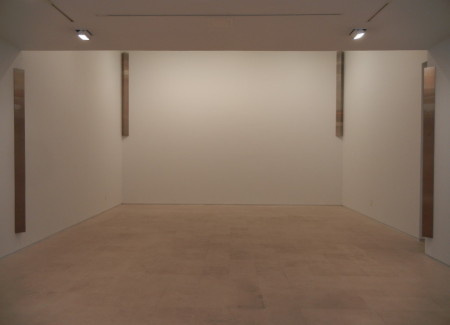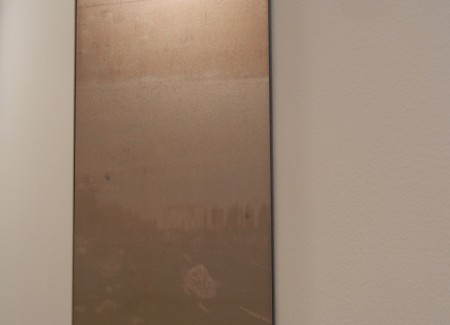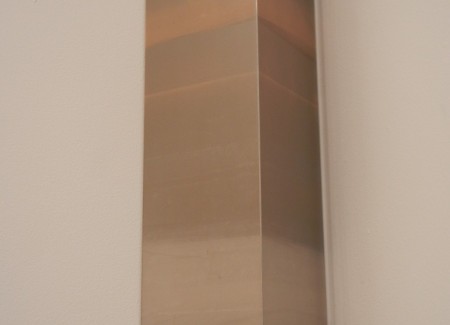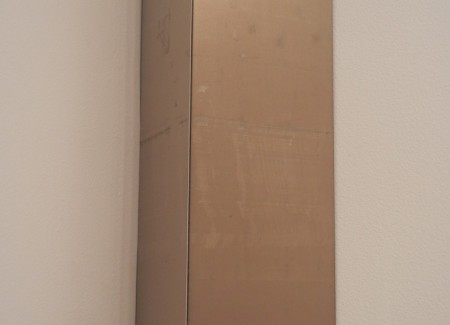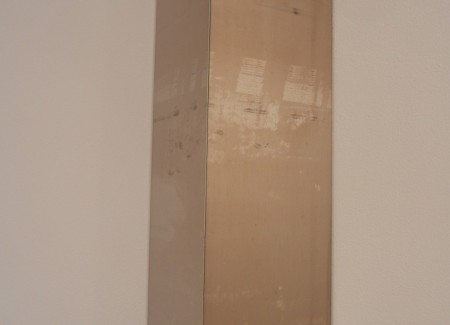JTF (just the facts): A four part installation, hung against white walls in the single room gallery space. Each section is made of unique silver toned photograms mounted on Dibond, each sized roughly 84x7x5; the overall dimensions are variable, depending on the larger space they inhabit. The work was made in 2012 and was originally installed at the Secession in Vienna (here). (Installation and detail shots below.)
Comments/Context: With each successive project, Liz Deschenes is becoming more and more of an architectural photographer. This doesn’t mean that she’s taking straightforward photographs of buildings; on the contrary, her works often appear to be of nothing at all. What it means is that she has increasingly turned her attention to the architect’s central question – the creation and definition of space.
For those looking for easily recognizable visual content, Deschenes’ work can be subtle and mysterious, and in some cases, downright inscrutable. Her photograms revel in minute nuances of chemical residue and tonal shifting, requiring close inspection to see the surface changes. Depending on how they are framed, the images can draw the viewer into dark, seemingly endless enveloping masses, or if covered with reflective glass, frustrate and repel our interest with stubborn mirrored reflection.
This particular work is made up of four pairs of long vertical photograms, hung edge to edge (unframed) like hinged corners or chevrons. From afar, they appear to be made of brushed stainless steel, like Minimalist railroad ties or totem poles. Up close, their surfaces begin to dance, with scuffs and marks, stripes and faint fingerprints emerging from the apparent uniformity. Each one plays with a spectrum of metallic color, from shiny silver to browner tones that echo platinum or sepia.
This work was originally installed in the Secession space in Vienna, and from the look of the installation photos, that space was much larger and flatter; the individual pieces were all hung mid wall, and when looked at from just the right squared off angle, appeared to create the receding lines of linear perspective. The Miguel Abreu gallery on Orchard Street is unusual in that the one room space telescopes inward, starting with a relatively tight, low ceilinged entry area and opening up with a slightly wider and much taller space in the back. Deschenes has installed the pieces differently this time, with two of the pieces hung much higher in the rear area. The effect is something akin to a tilting, an upward recalibration of the space from a fixed vantage point.
Part of what is going on here is an investigation of stereographic seeing, of creating the illusion of spatiality by combining two slightly off kilter perspectives. Deschenes’ sculptural vertical lines alter our perception of the gallery space, and in the New York version, bring a sense of the movement of a view camera to the room.
Another look at the Secession installs provides a clue to the other half of the ingenuity on view here. In Vienna, the photograms appear to be brightly silver, while here in New York, they look meaningfully darker. Even accounting for the differences in available light in the two spaces, the photograms appear to be changing, oxidizing and slowly evolving. These photographs aren’t fixed moments, but more like continuums of time, where Deschenes’ visual ideas are adapting to the space, continually reconfiguring themselves.
So while this installation seems to have all the trappings of minimalism, it is in fact deeply rooted in photographic thinking. For those who have only seen Deschenes’ work at art fairs or in group shows mixed in with other more conventional photography, this show will be that eureka moment when you finally understand and appreciate what she’s doing. I came to realize that her work strongly benefits from being seen in isolation, where the larger framework of how she’s manipulating the surrounding physical space can be clearly seen. Deschenes is extending photography in an original direction, playing on its object qualities and its underlying conceptual foundations to force it into broader interaction with architecture. The refinement of her overall vision is best seen in shows like this one, where she can control the entire elegant experience.
Collector’s POV: The works in this show (sold as a single set) were priced at $120000 and were already sold. Deschenes’ work has very little secondary market history, so gallery retail remains the best/only option for those collectors interested in following up.
